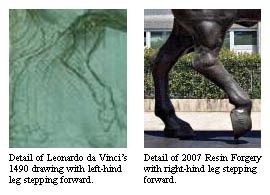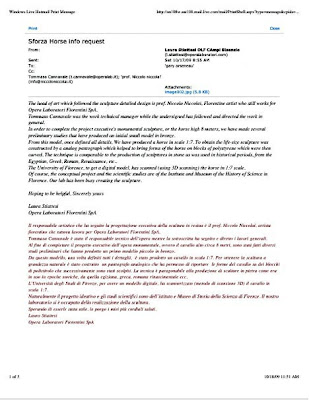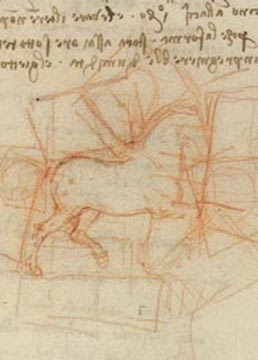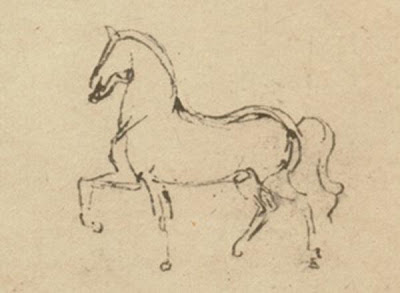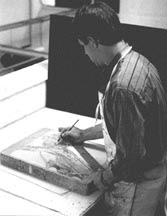Maxfield Parrish reproductions are not lithographs, yet the Trust for Museum and the Delaware Art Museum would have the public believe otherwise
NOTE: Footnotes are enclosed with [FN ].
POSTSCRIPT: At end of monograph.

The Lantern Bearers, 1910, Maxfield Parrish (1870-1966),
Lithograph, 11 1/2 x 8 3/4 inches.
http://www.delart.org/exhibitions/fantasies_fairytales.html
Maxfield Parrish reproductions are -not- lithographs.
The Delaware Art Museum and the Museum Trust are using the term "lithographs," in the Delaware Art Museum’s October 31, 2009 - January 10, 2010 Fantasies and Fairy-Tales: Maxfield Parrish and the Art of the Print exhibition, as a euphemism for reproductions.
On page 114 of Webster's New World Pocket Dictionary, -euphemism- is defined as: "mild word replacing an offensive one."[FN 1]
Lithographs, by law and definition, are original works of visual art “that must be wholly executed by hand by the artist”[FN 2] and “excludes any mechanical and photomechanical processes.”[FN 3]
In other words, lithographs would -never- be trivialized as a reproduction of anything, much less from Maxfield Parrish's "original paintings."[FN 4]
This monograph will document these contentious issues of authenticity surrounding these non-disclosed reproductions falsely attributed as original works of visual art ie., lithographs to Maxfield Parrish and at best a lack of connoisseurship by the lender Trust for Museum and the Delaware Art Museum, who as a member of the Association of Art Museum Directors, is violating their own endorsed ethical guidelines “that reproductions must be clearly indicated as reproductions.”
FIVE PUBLISHED REFERENCES
Here are five published references documenting Maxfield Parrish had his paintings reproduced resulting in reproductions.
LATEST AND BEST METHODS OF COLOR REPRODUCTION
First reference is the 1913 published American art directory, Volume 10 publication, where on page xv there is a full page advertisement by Lane Company (located at 113A West Street, New York) offering for sale six reproductions "for twenty-five cents each or one dollar for the portfolio of six,"[FN 5] one of which is titled: "'Dies Irae' By Maxfield Parrish."[FN 6] Those reproductions are described as follows: “A portfolio of six exquisite paintings by modern masters done into full colors by the latest and best methods of color reproduction. These plates were executed in England, where the art of color reproduction has reached its highest perfection. The size of the plates, with borders suitable for framing, is 13 by 10 inches.”[FN 7]
ILLUSTRATIONS INTENDED FOR REPRODUCTION
Second reference is the 1973 published Maxfield Parrish[FN 8]catalogue by Coy L. Ludwig. On page 190, the author wrote: "The poster designs and magazine illustrations made by Maxfield Parrish were intended for reproduction and it was necessary, therefore, for him to understand the method of reproduction in order for the publisher to obtain the best results.”[FN 9]
REPRODUCTIONS RIGHTS TO HIS ILLUSTRATIONS
Third reference is the Delaware Art Museum's published 1975 American painting and sculpture[FN 10]catalogue by Elizabeth H. Hawkes. On page 82, the author wrote: "In 1904, Maxfield Parrish signed a contract with Collier’s which provided $1,250 a month for reproduction rights to his illustrations."[FN 11]
PAINTINGS EXPECIALLY FOR REPRODUCTION
Fourth reference is the Brandywine River Museum's published 1991 Catalogue of the collection, 1969-1989.[FN 12] On page 121, it states: "Thereafter, Parrish was approached to create paintings especially for reproduction, of which his most famous was Daybreak (1922; issued as a print in 1923)."[FN 13]
THE MOST-REPRODUCED ARTIST EVER
Fifth and finally reference is the 2001 published Maxfield Parrish: the masterworks[FN 14]catalogue by Alma Gilbert-Smith. On page 165, the author wrote: "The artist’s work with Reinthal and Newman’s House of Art catapulted Parrish to the status of most-reproduced artist ever... His association with the House of Art came about through a series of events that snowballed to a veritable avalanche. The events can be traced back to 1904, when the Ladies’ Home Journal, to generate publicity for its 250th issue, announced a cover design competition with the first prize of $1,000. Six prominent illustrators participated. Among the others were Jessie Wilcox Smith and Harrison Fisher, who received second and third prizes, respectively, Parrish was awarded the coveted first prize for his painting Air Castles. Additional color reproductions of his paintings were offered to readers for ten cents. this was the beginning of what would become an avalanche of demand for Parrish prints. ...it was not a publisher or magazine that finally convinced Parrish to engage the art market with paintings created for the purpose of reproduction as art prints. It was the candy manufacturer, Clarence Crane, who pointed the way. Crane asked Parrish to produce a painting that would convert his candy boxes into works of art (thereby raising the price of the candy). Each box would carry an order blank inside so that customers could send for additional reproductions of the paintings.”[FN 15]
HOUSE OF ART ASKED TO REPRODUCE
Additionally, on page 167, the author wrote: "Parrish received nearly $50000 in royalties from the sale of prints of those three subjects. Crane’s little order blanks for the Parrish prints created an unprecedent demand for his reproduction, a demand which gained gigantic momentum. The House of Art asked to reproduce Garden of Allah, Rubaiyat, and Cleopatra, becoming in 1920 the exclusive publisher of all Parrish works designed for color reproduction for the art print market. (This was when Parrish was still creating the calendars for General Electric Mazda lamps.)"[FN 16]
Ironically, the Amazon.com's "Product Description," for the Maxfield Parrish, Master of Make-Believe catalogue, states: "The book accompanies an exhibition by the same name organised by the Trust for Museum Exhibitions, Washington, DC.[FN 17]
In other words, these five references, one of which was excerpted from the catalogue accompanying this October 31, 2009 - January 10, 2010 Fantasies and Fairy-Tales: Maxfield Parrish and the Art of the Print exhibition at the Delaware Art Museum, documents clearly that Maxfield Parrish had his paintings reproduced resulting in reproductions, not lithographs.

Maxfield Parrish (1870-1966), The Lantern Bearers, signed and dated 'Maxfield Parrish 1908.' (lower left), oil on canvas laid down on board, 40 x 32 in. (101.6 x 81.3 cm.) http://www.christies.com/LotFinder/lot_details.aspx?from=salesummary&intObjectID=4715256&sid=cef4c7af-855a-4c3e-be96-0c5a12c1bb4e
DELAWARE ART MUSEUM & COLOR LITHOGRAPHIC PRINTS FROM PAINTINGS
Yet, the Delaware Art Museum on their website for their upcoming Fantasies and Fairy-Tales: Maxfield Parrish and the Art of the Print exhibition would have the public believe that the "Fantasies and Fairy Tales is the first traveling exhibition of Maxfield Parrish’s color lithographic prints, made from his original paintings."[FN 18]
Lithographs versus reproductions are not interchangeable, much less the same.
WHAT IS A LITHOGRAPH?
On the International Fine Print Dealers Association's 2008 www.printdealers.com/learn.cfm website, "lithography" is defined as: "Literally, 'stone drawing,' the artist draws or paints the composition on the flat surface of a stone with a greasy crayon or liquid. The design is chemically fixed on the stone with a weak solution of acid and gum arabic. In printing, the stone is flooded with water which is absorbed everywhere except where repelled by the greasy ink. Oil-based printer's ink is then rolled on the stone, which is repelled in turn by the water soaked areas and accepted only by the drawn design. The stone is then run through the press with paper under light pressure, the final print showing neither a raised nor embossed quality but lying entirely on the surface of the paper."[FN 19]
Additionally, on page 574 in the 1991 The Fifth Edition of the Artist’s Handbook of Materials and Techniques by Ralph Mayer, the author wrote: “The major traditional graphic-arts processes of long standing and continued popularity are lithograph, etching, drypoint, woodcutting or wood engraving, aquatint, and soft-ground etching. ...The term “graphic arts” excludes all forms of mechanically reproduced works photographed or redrawn on plates; all processes in which the artist did not participate to his or her fullest capacity are reproductions.”[FN 20]
U.S. CUSTOMS REGULATIONS
This perspective is confirmed by the April 2006 U.S. Customs' Informed Compliance regulations that lithographs "must be wholly executed by hand by the artist"[FN 21] and "excludes mechanical and photomechanical reproduction."[FN 22]

Maxfield Parrish (1870-1966), Daybreak, signed and dated 'Maxfield Parrish 1922' (lower right), oil on board, 261⁄2 x 45 in. (67.3 x 114.3 cm.)
http://www.christies.com/LotFinder/lot_details.aspx?from=salesummary&intObjectID=4715251&sid=cef4c7af-855a-4c3e-be96-0c5a12c1bb4e

Daybreak, 1922, Maxfield Parrish (1870-1966), Lithograph, 17 3/4 x 29 1/2 inches
http://www.delart.org/exhibitions/fantasies_fairytales.html
TRUST FOR MUSEUM & LITHOGRAPHS FOR LITHOGRAPHIC REPRODUCTION
"Maxfield Parrish and the Art of the Print represents the first comprehensive sampling of Parrish's work in a variety of printed media" and "included in this exhibition is a full set of the calendars Parrish designed to promote General Electric's Edison Mazda Lamps, and many of the lithographs commissioned by the House of Art for the expressed purpose of lithographic reproduction"[FN 23] states the Trust for Museum on their website.
Once again, lithographs versus reproductions are not interchangeable, much less the same.
WHAT IS A REPRODUCTION?
On page 350 in the 1991 HarperCollins Dictionary of Art Terms & Techniques by Ralph Mayer, -reproduction- is defined as: “A general term for any copy, likeness, or counterpart of an original work of art or of a photograph, done in the same medium as the original or in another, and done by someone other than the creator of the original.”[FN 24]
This perspective is additionally confirmed on page 574 in the 1991 The Fifth Edition of the Artist’s Handbook of Materials and Techniques by Ralph Mayer where the author wrote: “The major traditional graphic-arts processes of long standing and continued popularity are lithograph, etching, drypoint, woodcutting or wood engraving, aquatint, and soft-ground etching. ...The term “graphic arts” excludes all forms of mechanically reproduced works photographed or redrawn on plates; all processes in which the artist did not participate to his or her fullest capacity are reproductions.”[FN 25]
MISREPRESENTATION
On page 1016 of the Seventh Edition of Black's Law Dictionary, -misrepresentation- is defined as: "The act of making a false or misleading statement about something, usu. with the intent to deceive."[FN 26]
So, when the Delaware Art Museum and the Trust for Museum both misrepresents reproductions of Maxfield Parrish's paintings as original works of visual art ie., lithographs, what is the public to make of such misrepresentation?
FRAUD
On page 670 of Seventh Edition of Black's Law Dictionary, -fraud- is defined as: "a knowing misrepresentation of the truth or concealment of a material fact to induce another to act to his or her detriment."[FN 27]
So, is it "a knowing misrepresentation of the truth or concealment of a material fact to induce another to act to his or her detriment," when the Delaware Art Museum misleads its' patrons into believing that these non-disclosed reproductions, of Maxfield Parrish's paintings, are original works of visual art ie., lithographs, for the admission price of $12 per adult[FN 28] and "grants from the Delaware Division of the Arts, a state agency dedicated to nurturing and supporting the arts in Delaware, in partnership with the National Endowment for the Arts?"[FN 29]
AAMD STATEMENT OF MISSION
The Association of Art Museum Directors’ “Statement of Mission,” as adopted in June 1996, in part, states: “The purpose of the Association of Art Museum Directors is to aid its members in establishing and maintaining the highest professional standards for themselves and the museums they represent.”[FN 30]
The Delaware Art Museum's executive director Danielle Rice is a member of Association Art Museum Directors.[FN 31]
What are those professional standards?
PROFESSIONAL PRACTICES IN ART MUSEUMS
On page 31 of the 2001 Association of Art Museum Director’s Professional Practices in Art Museums booklet, it is written that the: “misleading marketing of reproductions, has created such widespread confusion as to require clarification in order to maintain professional standards. - When producing and/or selling reproductions, museums must clearly indicate, through the use of integral markings on the objects, as well as signs, labels, and advertising, that these items are reproductions."[FN 32]
The AAMD requires of their members that: 1. “When producing and/or selling reproductions - signatures, edition numbers, and/or foundry marks on sculpture must not appear on the reproduction.,” 2.“ ...the fact that they are reproductions should be clearly indicated on the object.” and 3. “When advertising reproductions, museums should not use language implying that there is any identity of quality between the copy and the original or lead the potential buyer to believe that by purchasing any such reproductions, he or she is acquiring an original work of art.”[FN 33]
DELAWARE ART MUSEUM MISSION STATEMENT
The Delaware Art Museum's -Mission Statement- states it: "connects people to art, offering an inclusive and essential community resource that through its collections, exhibitions, and programs generates creative energy that sustains, enriches, empowers, and inspires."[FN 34]
TRUST FOR MUSEUM ENSURES INTELLECTUAL INTEGRITY
The Trust for Museum Exhibitions states they are: "a non-profit museum service organization founded in 1984 by Ann Van Devanter Townsend. Respected nationally and internationally for its splendid and scholarly exhibitions, the Trust’s hallmark on any fine or decorative arts project ensures intellectual integrity and outstanding aesthetic quality in both content and execution."[FN 35]
Is this AAMD member Delaware Art Museum, much less the Trust for Museum, violating their own professional standards by failing to adhere to their own endorsed ethical guidelines, and Mission Statement by leading potential museum patrons into believing these non-disclosed reproductions, of Maxfield Parrish's paintings, are original works of visual art ie., lithographs?
WHAT IS CONNOISSEURSHIP?
In Paul Duro & Michael Greenhalgh’s published Essential Art History, -connoisseurship- is defined as: “that of the art expert able to distinguish between the authentic and non-authentic, for example between an original and a copy.”[FN 36]
Is the commingling of reproductions and lithographs as if they are interchangeable, much less the same by the Delaware Art Museum and the Trust for Museum organization just a lack of connoisseurship ?
Someday, this Delaware Art Museum, much less the Trust for Museum organization, may successfully argue they did not understand the difference between lithographs and reproductions and had no idea of the ethical guidelines they endorse as a member of the AAMD but that would be an explanation, not an excuse.
CONCLUSION
What needs to be accomplished is the full and honest disclosure of reproductions as -reproductions- by all museums, auction houses, academia, galleries and art dealers. If the Delaware Art Museum, Trust for Museum and all other participants, in this October 31, 2009 - January 10, 2010 Fantasies and Fairy-Tales: Maxfield Parrish and the Art of the Print exhibition, will give full and honest disclosure to all reproductions as: -reproductions-, it would allow consumer the potential to give informed consent on whether to attend an exhibition of reproductions, much less pay the $12 price of adult admission.
But if those reproductions are not disclosed as -reproductions-, then potential serious consequences of law may come into play for those who chose to misrepresent those reproductions for profit.
The reputations and legacy of living and past artists, present and future consumers ie., the art-buying public deserve the re-establishment of the obvious; that the living presence and participation of the artist to once again be required, as it always should have been, to create the piece of art attributable to the artist if indeed it is attributed to them, much less purported to have been signed by them.
PRINCIPALS:
1) Danielle Rice
Executive Director
Delaware Art Museum
2301 Kentmere Parkway
Wilmington, Delaware 19806
302.571.9590 ext. 537
drice@delart.org
2) Ann Van Devanter Townsend
The Trust For Museum Exhibitions
1424 16th St NW Suite 600
Washington, DC 20036
(202) 745-2566
atownsend@tme.org
VENUES:
Crocker Art Museum - Sacramento, CA
May 8 - July 17, 2009
Venue 1
Wichita Art Museum - Wichita, KS
July 30 - October 11, 2009
Venue 2
Delaware Art Museum - Wilmington, DE
October 29, 2009 - January 10, 2010
Venue 3
R.W. Norton Art Gallery - Shreveport, LA
January 28 - April 11, 2010
Venue 4
Everson Museum of Art - Syracuse, NY
April 29 - July 11, 2010
Venue 5
Fresno Metropolitan Museum of Art- Fresno, CA
July 29 - October 10, 2010
Venue 6
Montgomery Museum of Fine Arts - Montgomery, AL
October 28, 2010 - January 9, 2011
Venue 7
Available
January 27th, 2011- March 27th, 2011
Venue 8
FOOTNOTES:
1) Copyright © 2000 by IDG Books Worldwide, Inc., ISBN 0-7645-6147-2
2)www.cbp.gov/linkhandler/cgov/trade/legal/informed_compliance_pubs/icp061.ctt/icp061.pdf
3) Ibid
4)http://www.delart.org/exhibitions/fantasies_fairytales.html
5)http://books.google.com/books?id=B_k5qJ8KnOsC&printsec=frontcover&dq=%22Florence+Nightingale+Levy,+American+Federation+of+Arts%22&ei=6ijhSpyvEKT8ygS73ICnDA#v=onepage&q=maxfield%20parrish&f=false
6) Ibid
7) Ibid
8) Publisher: [New York Watson-Guptill Publications [1973] (January 1, 1973), ISBN-10: 0823038971, ISBN-13: 978-0823038978, ASIN: B0026PVW40
9)http://books.google.com/books?ei=gTjhSr24E6CMygS695SMDA&id=BkEWAQAAIAAJ&dq=Maxfield+Parrish+By+Coy+L.+Ludwig&q=reproduction#search_anchor
10)Avant-Garde Painting & Sculpture in American 1910-25: Delaware Art Museum April 4 - May 18, 1975 (Paperback), Publisher: Delaware Art Museum (January 1, 1975), ASIN: B002TENWUU
11)http://books.google.com/books?ei=iy3hSu-VE4OwywSUt7nWCw&id=NVOwAAAAIAAJ&dq=American+painting+Delaware+Art+Museum&q=%241%2C250#search_anchor
12)Brandywine River Museum: Catalogue of the Collection, 1969-1989 (Paperback), by James Duff, Publisher: Brandywine Conservancy; First Edition edition (December 1, 1991), ISBN-10: 9992442808, ISBN-13: 978-9992442807
13)http://books.google.com/books?ei=_TDhSqPjPKq-ygSKoNDbCw&id=QaFPAAAAMAAJ&dq=Catalogue+of+the+collection%2C+1969-1989&q=DAYBREAK#search_anchor
14)Maxfield Parrish: The Masterworks [BARGAIN PRICE] (Hardcover)
by Alma Gilbert, Publisher: Ten Speed Press; 3 edition (March 1, 2004), ISBN-10: 1580083293, ASIN: B002IKLMG6
15)http://books.google.com/books?id=l9JDROoxawoC&printsec=frontcover&dq=Maxfield+Parrish:+the+masterworks&ei=uDLhSq_aEJTazQTFkoidDA#v=onepage&q=reproduction&f=false
16) Ibid
17)http://www.amazon.com/Maxfield-Parrish-Make-Believe-Alma-Gilbert/dp/0856676012/ref=sr_1_1?ie=UTF8&s=books&qid=1256273409&sr=1-1
18) http://www.delart.org/exhibitions/fantasies_fairytales.html
19) http://www.printdealers.com/learn.cfm
20) Copyright © Bena mayer, Executrix of the Estate of Ralph Mayer, 1991, ISBN 0-0670-83701-6
21)www.cbp.gov/linkhandler/cgov/trade/legal/informed_compliance_pubs/icp061.ctt/icp061.pdf
22) Ibid
23)http://www.tme.org/Exhibition%20Fantasies%20and%20Fairy-Tales.htm
24) Copyright © 1991 by Bena Mayer, ISBN 0-006-461012-8 (pbk.)
25) Copyright © Bena Mayer, Executrix of the Estate of Ralph Mayer, 1991, ISBN 0-0670-83701-6
26) Copyright © 1999, By West Group, ISBN 0-314-22864-0
27) Ibid
28) http://www.delart.org/visit/visit_info.html
29) Ibid
30) www.aamd.org/AAMDmission.shtml
31) http://aamd.org/about/#Members
32) Published in 2001 by the Association of Art Museum Directors, 41 East 65th Street, New York 10021 ISBN 1-880974-02-9
33) Ibid
34) http://www.delart.org/visit/visit_info.html
35) http://www.tme.org/About%20Us.htm
36) rubens.anu.edu.au/htdocs/teach/eah/
POSTSCRIPT (October 31, 2009):
On Friday, October 23, 2006, someone from the Delaware Art Museum (confirmed by their IP) anonymously commented on this monograph that the "posters you buy today and the images in newspapers are no less lithographs than those hand-created and printed by Daumier" and that this scholar was -ignorant-.
Sometime over the weekend, by Monday, October 26, 2009, the Delaware Art Museum changed their website, promoting their Fantasies and Fairy-Tales: Maxfield Parrish and the Art of the Print exhibition, from "color lithographic prints" to "color prints" with the following admission: "By the 1930s, Parrish realized he could free himself from the restrictions of advertising and magazine work and rely solely on color reproductions of his art."
To view the Delaware Art Museum's anonymous comment in totality and this scholar's reply, please read comments below.




